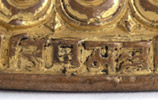In the Khasa Malla Tradition
A Thangka of Vikram Shahi (r. 1602-1631) King of Jumla
- click on the image to enlarge | click on the image again to enlarge further
click Esc or X to close and return to this page
Figure 5: The Dakini Nairatma
West Nepal or West Tibet, 1300-1325
Sculpture
Gilt copper
3 1/2 x 2 3/4 x 1 1/4 in. (8.89 x 6.99 x 3.18 cm)
Los Angeles County Museum of Art
Purchased with funds provided by Harry and Yvonne Lenart
(M.85.221)
https://collections.lacma.org/node/251195
Inscription, cast on the base in nagari, reads: śrī ripumalla ściraṃ jayatu, “May Śrī Ripumalla live long”
(The same inscription is seen on the painting of White Tara of fig. 7 and is found as a graffiti on the Ashokan pillar inscription of Niglihawa in the Nepal Terai, while a similar inscription is found as a graffiti on the nearby Lumbini Ashokan pillar)
Published:
Alsop, Ian, "The Metal Sculpture of the Khasa Mallas of West Nepal/West Tibet" in Orientations, (June 1994)
Alsop, Ian, "The Metal Sculpture of the Khasa Mallas of West Nepal/West Tibet" in Singer, ,J.C.; Denwood, P. eds. Tibetan Art: Towards a Definition of Style. London: Laurence King Publishing, 1997.
Reedy, Chandra L. Himalayan Bronzes: Technology, Style and Choices. Newark: University of Delaware Press, 1997.
Alsop, Ian, "The Metal Sculpture of the Khasa Mallas of West Nepal/West Tibet" asianart.com: August 26, 2005, https://www.asianart.com/articles/khasa/index.html
detail 1: original photo in Alsop, 1994,1997 and 2005
detail 2: inscription
detail 3: Machig Labdrön
(Ma-gcig lab-sgron)
West Nepal or West Tibet, 1312
Gilt copper
5.9 n x 4.5 x 3.15 in. (15 x 11.5 x 8 cm)
Alain Bordier Foundation
Tibet Museum, Gruyeres, Switzerland
ABS 152
photo: Alain Bordier Foundation
Inscription inscribed on the base in nagari, reads:
śrī madanimalla ściraṃ jayatu, śake 1234
“May Śrī Madanimalla live long: Saka (samvat)1234” (1312 CE)
Madani Malla may be a queen of Ripu Malla . This was the same year that king Ripu Malla left a graffiti inscription śrī ripumalla ściraṃ jayatu on the Ashokan pillar of Niglihawa, in the Nepal Terai, which is the same inscription of the main fig. 5 Nairatma and also fig. 8 White Tara.
Published:
Beguin, Gilles, 2013, Art Sacre du Tibet: Collection Alain Bordier; catalogue of a exhibition at the Fondation Pierre Berge – Yves Saint Laurent, Paris March 14 – July 21, 2013 (Paris: Editions Findakly) p. 115, pl 45



